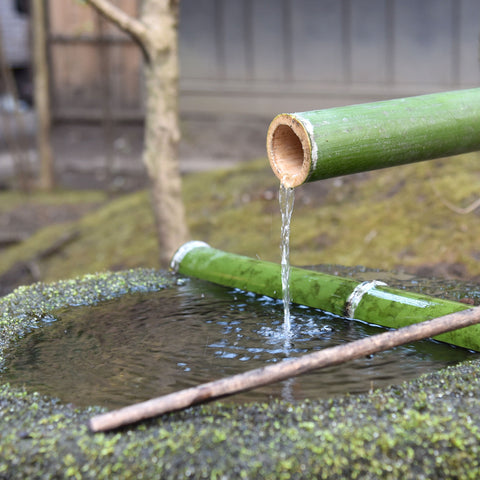
I never felt like I could explain just how deep and complex the chasen (matcha whisk) making culture is in Japan. But all of it became clear to me after meeting Yasaburo Tanimura and his son Keiichiro Tanimura of Suikaen Tanimura Chasen in the Takayama region in Nara, this past spring.
Upon driving up to the family's property, I saw bamboo sticks in teepee-like formations. The pink of the ume blossoms contrasted with the green stalks, providing an unbelievably Japanese landscape.

Both father and son welcomed me in at the entrance.

We got settled into the front room, where the warm, crisp spring light poured in. While Keiichiro-san talked to me about their craft, his father settled into his chair, quietly working. The father and son gave me a perfect demonstration of why this craft is so special – I took in the words of the son while watching his father worked skillfully right in front of my eyes.
 Yasaburo Tanimura working at his station
Yasaburo Tanimura working at his station



The Tanimura family has been at this house making chasen for 530 years. Yasaburo-san (the father) is the 25th generation chasen maker in his family. Keiichiro-san will be the 26th. Keiichiro-san has been trained to make chasen, but he explains, "My father has not yet accepted my work as a product." Therefore, it will still take time for Keiichiro-san to take the reins completely.
When competition of chasen-making was fierce in the region, Keiichiro-san said that generations before only worked in the middle of the night for fear of having their chasen-making secrets stolen. This continued into Yasaburo-san's generation, as Keiichiro-san recounted his father sleeping from 5am-1pm after working all night. Yasaburo-san still says he works best at night because there are no interruptions.

There are three different types of bamboo for three different schools of tea:
Hachiku (white bamboo) - Urasenke school
Shichiku (purplish black) - Mushanokoji school
Susudake (reddish bamboo harvested from 200 year old thatched roof houses in Japan, now mostly in Shiga) - Omotesenke school
 A mix of hachiku, susudake, and shichiku bamboo
A mix of hachiku, susudake, and shichiku bamboo
I asked Keiichiro-san what the main differences are between Japanese-made and foreign-made chasen. He clarified for me the difference between Japanese and those made elsewhere (mostly China) – time and craft. Tanimura-san will harvest three-year old hachiku bamboo in the dead of winter when the bugs in the bamboo go underground. Then they boil the bamboo to remove the oil from the inside of the stalks. From there, they sun bleach them to get rid of water and bugs for one to two months, typically in January and February. When exposed to sunlight, the ultraviolet rays change the color of the bamboo from green to a beautiful milky white. This is done chemically outside of Japan which means the bamboo does not have that milky color.
After a month, they cure the bamboo in their shed for two years. There is a silica pack in the Chinese made whisks because they do not cure the bamboo for two years. Kenichiro-san says, "The reason we spend so much time (curing) is to increase the flexibility and durability of bamboo."
 Keiichiro-san in front of their curing shed
Keiichiro-san in front of their curing shed
The other difference is that curling is done by hand in Japan, while in China it is done by heat. You will see that this takes great skill to do. The heat curled versus hand-curled chasen look strikingly different. Keichiro-san outlines the curling process step-by-step:
1. 片木 (Hegi): peel one-third of the bamboo skin and divide it into 16 equal parts. Then separate skin and endodermis each of the parts, and cut out the endodermis.
2. 小割 (Kowari): divide 1 mm divided into 0.4mm and 0.6mm.
3. 味削り (Ajikezuri): Make the all bristles thinner just like your hair.
4. 面取り (Mentori): Shave the edge each of the bristles to round off the corners.
5. 下編み (Shitaami): Separate inner (0.4mm) and outer (0.6mm) bristles alternately with a thread.
6. 上編み (Uwaami): To keep the shape of the Chasen, knit the inner and outer bristles twice.
7. 仕上げ (Shiage): Arrange the each of the bristles to make beautiful shape.
Finally, there are no bleaching or chemicals applied to the bamboo in Japan, leaving the "imperfections" of the bamboo for the user to see. He says that the whisks made outside of Japan look unusually clean.

 The progression in stages
The progression in stages
The family business employs 30 people, but they only complete 20 chasen per day.

We are proud to say that we started importing these special chasen from Suikaen. The Tanimura family kindly wrapped the Shin Chasen in Umami Mart Red thread. These will be especially close to my heart and remind me of my visit that concluded with a delicious treat of matcha and wagashi in their beautiful tea room.


I want to thank the Tanimura family for welcoming me into their home and patiently explaining the whole process to me. Every time I see one of their chasen, I admire them as works of art.




Comments (0)
There are no comments for this article. Be the first one to leave a message!